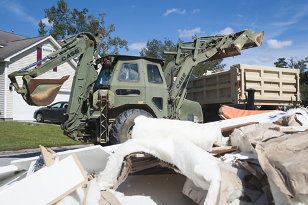When working on cleanup and rebuilding efforts after a severe weather event, it's important to be aware of potential asbestos-containing materials that could pose a health risk if not handled properly. Disturbing asbestos-containing materials during building repairs, renovations, or demolitions can release asbestos fibers or dust particles into the air, allowing them to be ingested or inhaled.
- Download the Asbestos Fact Sheet for Severe Weather Event.
Presence of asbestos
Because of its fiber strength and heat resistance, asbestos has been used in a variety of building materials such as siding, ceiling and floor tiles, stucco, sheetrock/joint compound, ceiling texture (popcorn ceiling), caulking, mastics, insulation, and roofing materials. Regardless of the age of a building, asbestos-containing materials may have been used during construction of the building. Structures built before 1980 are the most likely to have asbestos-containing materials. Newer buildings are less likely to have large quantities of asbestos.
What Is regulated?
Federal and state asbestos regulations typically do not apply to work done in residential buildings having four or fewer dwelling units. However, if a homeowner wants a licensed asbestos contractor to remove materials, make repairs, or renovate or demolish their home, the contractor must comply with all asbestos regulations.
The regulations do apply to any institutional, commercial, public, or industrial building, including condominiums or individual dwelling units operated as a residential cooperative.
Exposure to asbestos
Asbestos fibers may be released into the air by disturbing asbestos-containing materials during building repairs, renovations, or demolitions. In general, exposure may occur only when the asbestos-containing material is disturbed or damaged in such a way that releases dust particles and fibers into the air. Asbestos-containing materials that have not been disturbed can safely remain in place.
People at greatest risk for health effects from asbestos
People exposed to asbestos on a regular basis, such as contractors who don't follow federal and state health-protective regulations for asbestos, are most at risk for developing asbestos-related diseases. Those who are exposed to large amounts of asbestos over a period of time have a greater chance of developing harmful health effects, such as lung cancer or other respiratory diseases. Disease symptoms may take many years to develop after being exposed to asbestos.
Minimizing asbestos exposure
If homeowners decide to do work on their homes themselves or hire a non-licensed asbestos contractor, the following work practices and procedures should be followed to minimize airborne asbestos fiber releases and personal exposure:
- Keep the material that may contain asbestos wet at all times. A low-pressure garden sprayer adjusted to "mist" can be used. Water helps keep asbestos fibers from becoming airborne.
- Avoid tearing, ripping, chipping, cutting, or grinding materials that may contain asbestos, such as those listed above. These actions increase the potential for asbestos fibers to be released.
- Do not throw or drop materials that may contain asbestos to the ground. Instead, lower them carefully to prevent breakage and release of fibers to the air.
- Dispose of any asbestos-containing material at a landfill that accepts asbestos. Click here for a list of landfills that accept asbestos.
- Obtain a disposal permit from the Asbestos Section before you dispose of asbestos-containing material by using this link for a Notification of Residential Non-friable Asbestos Abatement Project. This notification must be submitted to the Asbestos Section in order for the homeowner to receive a disposal permit.
Owners of regulated buildings must use DHEC-licensed asbestos removal contractors to remove regulated asbestos containing materials before renovation or demolition activities can take place. These contractors must comply with state and federal asbestos regulations.
Licensed contractors
DHEC issues licenses for asbestos contractors. A list of licensed contractors that can perform asbestos abatement and demolition activities in South Carolina can be found by clicking here.
More information
Additional information about asbestos is available at www.scdhec.gov/asbestos or by calling (803) 898-4289.
